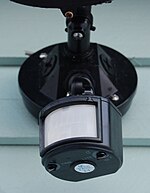Motion detector
 |
| A motion detector attached to an outdoor, automatic light. |
 |
Inexpensive Asian-made motion detector used to control the lightingA motion detector is a device that detects moving objects, particularly people. A motion detector is often integrated as a component of a system that automatically performs a task or alerts a user of motion in an area. Motion detectors form a vital component of security, automated lighting control, home control, energy efficiency, and other useful systems.Overview
Inexpensive Asian-made motion detector used to control the lighting
An electronic motion detector contains an optical, microwave, or acoustic sensor, and in many cases a transmitter for illumination. However a passive sensor only senses a signal emitted by the moving object itself. Changes in the optical, microwave, or acoustic field in the device's proximity are interpreted by the electronics based on one of the technologies listed below. Most inexpensive motion detectors can detect up to distances of at least 15 feet (5 meters). Specialized systems are more expensive but have much longer ranges. Tomographic motion detection systems can cover much larger areas because the radio waves are at frequencies which penetrate most walls and obstructions, and are detected in multiple locations, not just at the location of the transmitter.
Motion detectors have found wide use in domestic and commercial applications. One common everyday application is activation of automatic door openers in businesses and public buildings. Motion sensors are also widely used in lieu of a true occupancy sensor in activating street lights or indoor lights in walkways (such as lobbies and staircases). In such "Smart Lighting" systems, energy is conserved by only powering the lights for the duration of a timer, after which the person has presumably left the area. A motion detector may be among the sensors of a burglar alarm that is used to alert the home owner or security service when it detects the motion of a possible intruder. Such a detector may also trigger a security camera in order to record the possible intrusion.
|
Sensor technology
Infrared detector mounted on circuit board, along with photoresistive detector for visible light (left)
There are several motion detection technologies in wide use:
Passive infrared
Passive infrared sensors are sensitive to a person's skin temperature through emitted black body radiation at mid-infrared wavelengths, in contrast to background objects at room temperature. No energy is emitted from the sensor, thus the name "passive infrared" (PIR). This distinguishes it from the electric eye for instance (not usually considered a "motion detector"), in which the crossing of a person or vehicle interrupts a visible or infrared beam.
Microwave
These detect motion through the principle of Doppler radar, and are similar to a radar speed gun. A continuous wave of microwave radiation is emitted, and phase shifts in the reflected microwaves due to motion of an object toward (or away from) the receiver result in a heterodyne signal at low audio frequencies.
Ultrasonic
An ultrasonic wave (sound at a frequency higher than a human can hear) is emitted and reflections from nearby objects are received.[1] Exactly as in Doppler radar, heterodyne detection of the received field indicates motion. The detected doppler shift is also at low audio frequencies (for walking speeds) since the ultrasonic wavelength of around a centimeter is similar to the wavelengths used in microwave motion detectors. One potential drawback of ultrasonic sensors is that the sensor can be sensitive to motion in areas where coverage isn't desired, for instance, due to reflections of sound waves around corners.[2] Such extended coverage may be desirable for lighting control, where the point is detection of any occupancy in an area. But for opening an automatic door, for example, one would prefer a sensor selective to traffic in the path toward the door.
Tomographic motion detector
Tomographic motion detection systems sense disturbances to radio waves as they pass from node to node of a mesh network. They have the ability to detect over complete areas because they can sense through walls and obstructions.
Video camera software
With the proliferation of inexpensive digital cameras capable of shooting video, it is possible to use the output of such a camera to detect motion in its field of view using software. This solution is particularly attractive when the intention was to record video triggered by motion detection, as no hardware beyond the camera and computer is required. Since the observed field may be normally illuminated, this may be considered another passive technology. However it can also be used in conjunction with near-infrared illumination to detect motion in the "dark" (that is, with the illumination at a wavelength not detected by the human eye).
Dual-technology motion detectors
Many modern motion detectors use combinations of different technologies. While combining multiple sensing technologies into one detector can help reduce false triggering, it does so at the expense of reduced detection probabilities and increased vulnerability. For example, many dual-tech sensors combine both a PIR sensor and a microwave sensor into one unit. In order for motion to be detected, both sensors must trip together. This lowers the probability of a false alarm since heat and light changes may trip the PIR but not the microwave, or trees may trigger the microwave but not the PIR. If an intruder is able to fool the PIR or microwave, however, the sensor will not detect. Dual-tech sensors are only as strong as their weakest link.
Often, PIR technology will be paired with another model to maximize accuracy and reduce energy usage. PIR draws less energy than microwave detection[dubious – discuss], and so many sensors are calibrated so that when the PIR sensor is tripped, it activates a microwave sensor. If the latter also picks up an intruder, then the alarm is sounded.
Thanks for sharing very helpful information. I found another Microwave Sensor in Delhi, site , they provide very helpful services.
ReplyDelete